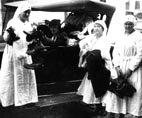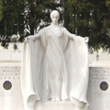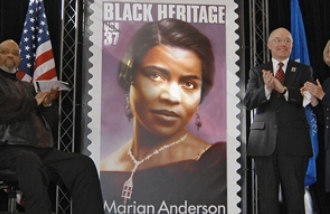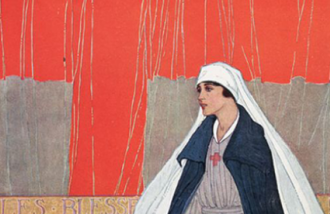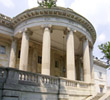
For Immediate Release
- Press Contact:
- Bren Landon
- [email protected]
- (202) 572-0563
On a visit to a museum, you may admire a piece of ornate furniture for its beauty, while others are intrigued by its statement of social status, while still others may see clues that make them question its purported date of origin. Then there are others whose main concern is how to store and care for the delicate piece so that many years down the line, even more people will have the chance to view the piece and interpret it with their own personal perspective. “Try to See It My Way: Behind the Scenes at the DAR Museum,” examines the notion that there is more than one way to look at a museum object. The exhibition, on display at the DAR Museum April 8 through September 3, 2011, gives visitors a peek into the minds of educators, curators and registrars as they create an exhibition of fascinating objects from the DAR Museum collection.
Visitors can explore unique and significant historic artifacts while also learning about the different roles performed by the DAR Museum staff in the analysis, contextualization and upkeep of the collection. Objects in the DAR Museum collection often have particularly interesting back-stories because many donors are DAR members, women who have traced their lineage back to a patriot of the American Revolution, who keep detailed accounts of their family history which they then are able to provide along with the piece. Visitors are encouraged to become part of the dialog of the exhibition and share their comments and questions. The DAR Museum will share that ongoing feedback and answer questions online at www.dar.org/share.
Dividing into teams of their respective roles, the DAR Museum educators, curators and registrars chose objects from the collection and used their unique perspective based on their job to write the object labels. Symbolized on the exhibition walls by colorful cartoon characters, the experts then also provided some comments about objects in each other’s sections to show how one object can be viewed in a variety of ways.
From the educator’s perspective, their role is to enhance the learning experience for the museum visitor. They present information about objects to visitors of all ages and place the objects in the context of history. The educator section of the exhibition features items with interesting stories and gives historical commentary on objects related to women and children. A quilt on display illustrates how sometimes museum objects have questionable histories associated with them. The educator explains that the donor of the wool quilt told the museum it was made from Civil War uniforms from members of the same family who fought on different sides in the war, but genealogical research has been unable to confirm this. The curator provides extra commentary that the fabrics do not conform with those used in Civil War uniforms, while the registrar describes how the quilt is stored. The educator’s goal is to present the facts and let the visitors draw their own conclusion, but can still make the point that items like these, regardless of their story’s validity, were made to commemorate or memorialize a person or event.
Educators also encourage visitors to make connections in order to help them understand how different life was compared to today…or maybe how similar. A woman’s elegant chatelaine with accessories such as a watch, knife, pincushion, thimble, pencil and note pad may prompt some visitors to envision a contemporary tool belt or a “fanny pack.” While the chatelaine was used inside the house, more adventurous women were wearing a silver clip and cord skirt holder to hold their dresses up when they rode a bicycle, much as cyclists roll their pant legs up today to avoid it getting caught in their chains.
The curator section of the exhibition displays a range of portraits, furnishings, quilts and costumes. Curators become experts in studying objects like these through examining, researching and writing about museum objects. Many curatorial discoveries and surprises are showcased in this section. A mahogany arm chair, originally part of a set ordered by President James Monroe for the White House, shows characteristics of French fashion of the time, but actually it was commissioned from a Georgetown cabinet maker to appease Congress after Monroe upset them a few years earlier for ordering a similar gilded set from France. The owner of a dress in the collection was finally identified after a curator found a newspaper clipping with a photo of a DAR member wearing the dress – saying it had belonged to Caroline Scott Harrison, First Lady of President Benjamin Harrison and first President General of the DAR. After a portrait conservation, curators were surprised and excited to learn that what they thought was just an image of a woman, actually was originally a portrait of a mother and child – raising the question, “why was the infant painted over?”
Two unique displays show a dress, with arrows and labels pointing to its different seams and fabric, and a table top, with views of its underside, to illustrate how a curator investigates the clues of a piece to learn more about it than just the family history that may accompany it. By analyzing materials used, methods of construction and stylistic details, curators can sometimes determine the “who-what-when-where” directly from the object itself.
While many visitors may have some knowledge of the role educators and curators play in a museum, the role of the registrar truly is behind the scenes, but just as crucial. Registrars maintain records of accession, condition and location of objects in a museum collection and oversee movement, packing and shipping of objects to conform to insurance regulations. This section of the exhibition shows visitors how museum objects are stored, how they are located and how they are cared for.
Objects like a late 19th century toy boat and toy elephant are displayed in the mounts used for their long-term storage to ensure their safety from damage. Other displays illustrate the challenges of efficiently labeling objects: how do you put an accession number on a bullet, or how do you number a chair so visitors can’t see it but registrars don’t have to contort themselves to find it. And lest you think the role of a registrar seems mundane, in addition to taking precautions to protect the historic pieces, they also must think of safety concerns for the entire museum. DAR Museum registrars must work with firearms professionals to ensure historic powder flasks, pistols and cannon balls no longer contain gun powder and are inoperable because, “Nothing ruins the Registrar’s day more than blowing up a storage area!”
This innovative exhibition is fun and educational for all ages as it takes the visitor behind the scenes of professional museum roles and duties. “Try to See It My Way” is a rewarding experience in that it not only answers many frequently asked questions about putting together an exhibition but it also makes the visitor part of the exhibition. Visitors are presented with questions and encouraged to share their own thoughts and questions right on the exhibit wall with a sticky note or by emailing the museum at [email protected]. That visitor feedback will be shared and answered online throughout the exhibition at www.dar.org/share. So stop by the DAR Museum to tell us the way YOU see it.
To see images from the exhibition and behind the scenes photos of the DAR Museum, visit our Facebook page at www.facebook.com/TodaysDAR.


